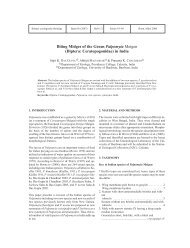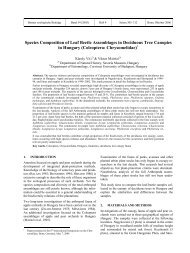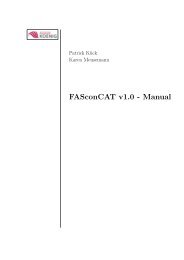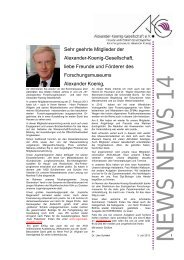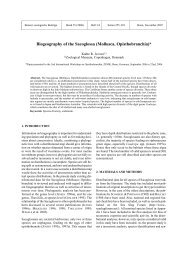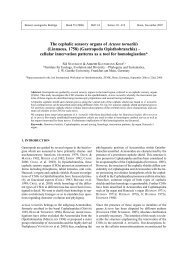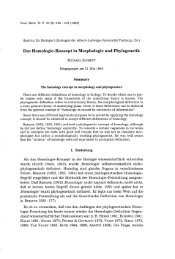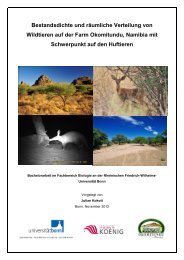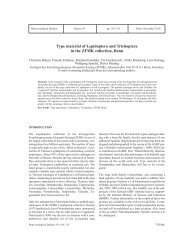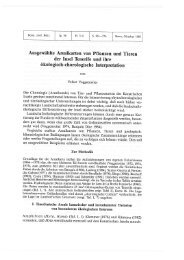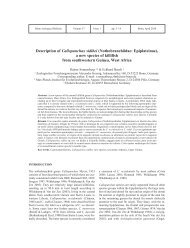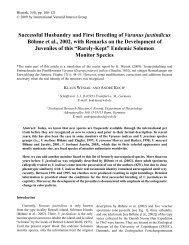Islands Between the Realms: A Revised Checklist of the ...
Islands Between the Realms: A Revised Checklist of the ...
Islands Between the Realms: A Revised Checklist of the ...
You also want an ePaper? Increase the reach of your titles
YUMPU automatically turns print PDFs into web optimized ePapers that Google loves.
108 André KOCH et al.: A <strong>Revised</strong> <strong>Checklist</strong> <strong>of</strong> <strong>the</strong> Herpet<strong>of</strong>auna <strong>of</strong> <strong>the</strong> Talaud Archipelago, Indonesia<br />
1. INTRODUCTION<br />
The Talaud Archipelago represents <strong>the</strong> nor<strong>the</strong>rn most area<br />
within <strong>the</strong> Wallacea transition zone between <strong>the</strong> Oriental<br />
and Australian faunal regions. The remote island group lies<br />
in <strong>the</strong> nor<strong>the</strong>rn Molucca Sea between North Sulawesi,<br />
Mindanao in <strong>the</strong> sou<strong>the</strong>rn Philippines, and Halmahera in<br />
<strong>the</strong> nor<strong>the</strong>rn Moluccas. The Talaud Archipelago comprises<br />
three main islands: Karakelong, Salibabu and Kaburuang<br />
(Fig. 1). Geologically, <strong>the</strong> Molucca Sea Plate with its<br />
inverted U-shape dips east under Halmahera and west under<br />
<strong>the</strong> Sangihe Arc (MCCAFFREY et al. 1980). The Talaud<br />
<strong>Islands</strong> are situated on <strong>the</strong> Sangihe forearc separated by<br />
a deep ocean trench from <strong>the</strong> largely submarine Sangihe<br />
Arc with its few emergent volcanic islands like Sangihe<br />
and Siau (HALL 2002). The Talaud Island group consists<br />
<strong>of</strong> a sedimentary sequence <strong>of</strong> Middle Miocene to Pleistocene<br />
age and includes probable mid-Miocene volcanic<br />
rocks and volcaniclustic turbidites (MOORE et al. 1981).<br />
Pleistocene coral limestone, <strong>the</strong> youngest rocks on Talaud,<br />
are exposed mostly along <strong>the</strong> coast lines (Fig. 2), but also<br />
at 400–500 m elevation on Kaburuang, showing <strong>the</strong> significant<br />
amount <strong>of</strong> recent uplift (MOORE et al. 1981). The<br />
highest elevation <strong>of</strong> only 650 m above sea level is found<br />
on Karakelong Island.<br />
The Talaud <strong>Islands</strong> toge<strong>the</strong>r with Sulawesi and o<strong>the</strong>r islands<br />
<strong>of</strong> present day central Indonesia belong to a biogeographic<br />
transition region called Wallacea (see summaries<br />
by MAYR [1944] and SIMPSON [1977]). Australopapuan and<br />
Asian animals meet at <strong>the</strong> respective outer limits <strong>of</strong> <strong>the</strong>ir<br />
distribution. Consequently, in <strong>the</strong> light <strong>of</strong> biogeography,<br />
<strong>the</strong> Talaud <strong>Islands</strong> form <strong>the</strong> nor<strong>the</strong>rnmost submerged area<br />
<strong>of</strong> this region. Traditionally, <strong>the</strong> Talaud Archipelago has<br />
been dealt with scientifically with Sulawesi to which it is<br />
indirectly connected via <strong>the</strong> Sangihe Island arch. However,<br />
<strong>the</strong> direct over-water distance to North Sulawesi <strong>of</strong><br />
about 300 km is significantly more distant than Halmahera<br />
in <strong>the</strong> Moluccas (ca. 210 km) or Mindanao in <strong>the</strong><br />
Philippines (ca. 170 km).<br />
Fig. 1.<br />
Map <strong>of</strong> <strong>the</strong> Talaud <strong>Islands</strong> located between Sulawesi, Halmahera (Moluccas) and Mindanao (Philippines).




